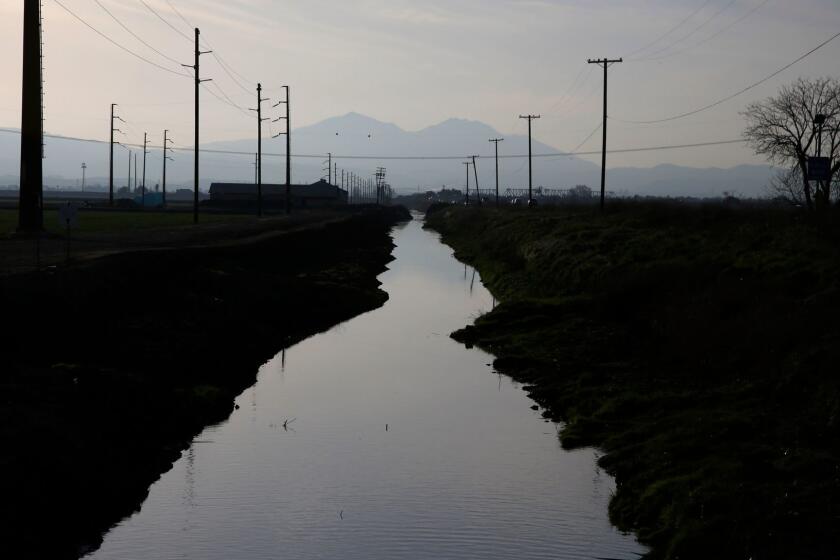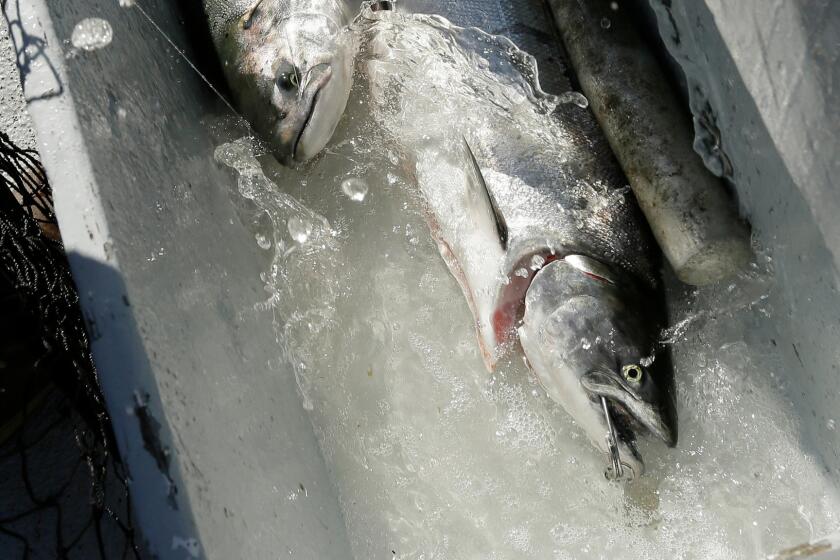Should L.A. care about salt in New Orleans’ tap water? Yes. Here’s why

- Share via
Los Angeles residents would be wise to keep an eye on New Orleans, where saltwater from the Gulf of Mexico is creeping up the Mississippi River and threatening the drinking water supply. Officials are tracking the daily movements of the saline wedge, which was predicted to reach some of the city’s water intake valves by Thanksgiving. More recent forecasts hold out hope that most intakes will escape saltwater contamination.
The central United States baked in record-breaking heat and suffered through below-average rainfall this summer, dropping the usually mighty Mississippi to extremely low levels for the second year in a row. The greatly diminished flow to the gulf currently lacks the volume to push back the heavy, salt-laden gulf water, which sneaks upstream along the river bottom.
Gov. Gavin Newsom’s single delta tunnel will work only if he learns from his predecessor’s twin-tunnels mistakes.
At first blush, there might seem few similarities between semi-arid L.A., with its average of just under 15 inches of rainfall a year, and soggy New Orleans, with its annual 62 inches and its setting on one of the world’s greatest waterways.
But in fact, the two cities have challenges in common because they both get their water from deltas — interfaces between fresh river water and salty bays. Parts of California’s delta, east of the San Francisco Bay, look so much like the Mississippi that they were used in movies such as “The Adventures of Huckleberry Finn.” The famous Delta Queen steamboat that now plies the Mississippi was built in Stockton to move passengers and freight in California.
Southern California’s survival does not require snuffing out salmon, Stocktonians or our neighbors in other parts of the state.
Delta water bound for L.A. is pulled by giant pumps into the California Aqueduct to make its way south. When drought or agricultural diversions diminish the flow into the delta from either the Sacramento River to the north or the San Joaquin River to the south, brackish bay water can push its way up the delta toward the pumps.
California’s advantage is that the pumps can simply be switched off, so that bay water never comes to L.A.’s taps the way gulf water may contaminate New Orleans’ supply in a few weeks. When the pumps are off, though, Southern California doesn’t get any delta water at all.
In years of average rainfall, when pumps at the south end of the Sacramento-San Joaquin River Delta lift water to two parallel aqueducts to begin the journey to Central Valley fields and Southern California households, the suction reverses the flow of the San Joaquin River, one of the state’s two main freshwater arteries.
One proposed solution is a bypass — a giant tunnel that would take pure Sacramento River water directly to the aqueduct without passing it through the delta.
But if some of the river flows through the tunnel, there would be even less freshwater in the delta to push bay water back. Much as salty Gulf of Mexico water currently threatens southern Louisiana, intruding San Francisco Bay brine could wreck groundwater supplies and make cities in the middle of the state, including Stockton, unlivable.
California is not merely a political jurisdiction drawn on a map.
A common slogan in California agribusiness and among politicians who support it is that water flowing through the delta that could be siphoned off for crops is instead “flushed out to sea.” The term invokes the ultimate waste — as if good, useful water is instead flushed down the toilet in order to protect delta smelt or migrating Chinook salmon.
To the contrary, though, healthy rivers keep the sea in its place. Diminish the flow, and saltwater contaminates the drinking water supply and the entire natural system that sustains human populations, not just wildlife. River water that moves downstream while farms go dry and lawns go brown is not waste. New Orleans would be glad to have more water to “flush” downstream right now. It would keep gulf water in the gulf.
As the March rains loosen more Southern California mud and fill more Northern California reservoirs, the state still flirts with drought and we still run short of water.
California water officials in recent weeks released proposed updates to a plan to sustain the delta amid unpredictable climate patterns and rising sea levels. Meanwhile, the delta bypass (state officials prefer to call it a “conveyance”) is in the midst of complex environmental review. The battle between competing interests is often framed as north versus south, or farms versus fish.
Californians should remember that it’s also a matter of rivers versus the sea. Any state water project or policy worth its salt must permit enough river water to move through the state to ensure that the ocean stays in its place, and that Los Angeles — and Stockton, and every place in between — never faces the problem that currently confronts New Orleans.
More to Read
A cure for the common opinion
Get thought-provoking perspectives with our weekly newsletter.
You may occasionally receive promotional content from the Los Angeles Times.












